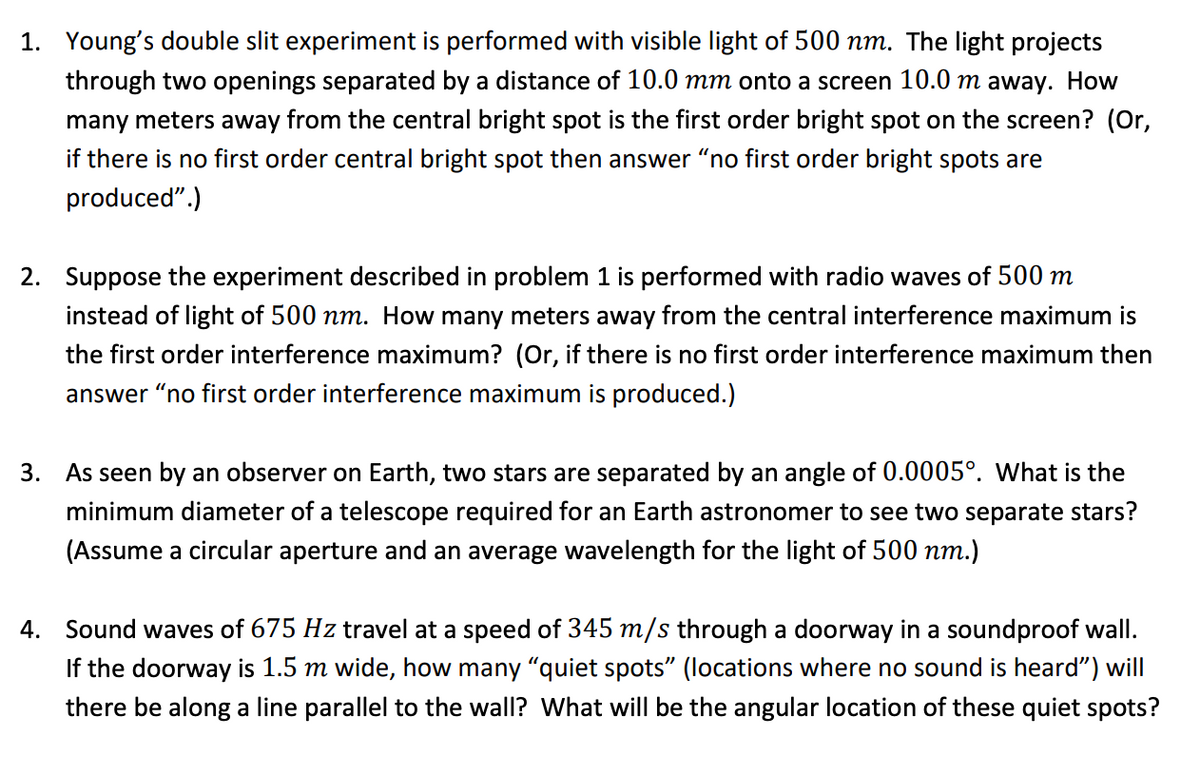1. Young's double slit experiment is performed with visible light of 500 nm. The light projects through two openings separated by a distance of 10.0 mm onto a screen 10.0 m away. How many meters away from the central bright spot is the first order bright spot on the screen? (Or, if there is no first order central bright spot then answer "no first order bright spots are produced".) 2. Suppose the experiment described in problem 1 is performed with radio waves of 500 m instead of light of 500 nm. How many meters away from the central interference maximum is the first order interference maximum? (Or, if there is no first order interference maximum then answer "no first order interference maximum is produced.) 3. As seen by an observer on Earth, two stars are separated by an angle of 0.0005°. What is the minimum diameter of a telescope required for an Earth astronomer to see two separate stars? (Assume a circular aperture and an average wavelength for the light of 500 nm.) 4. Sound waves of 675 Hz travel at a speed of 345 m/s through a doorway in a soundproof wall. If the doorway is 1.5 m wide, how many "quiet spots" (locations where no sound is heard") will there be along a line parallel to the wall? What will be the angular location of these quiet spots?
1. Young's double slit experiment is performed with visible light of 500 nm. The light projects through two openings separated by a distance of 10.0 mm onto a screen 10.0 m away. How many meters away from the central bright spot is the first order bright spot on the screen? (Or, if there is no first order central bright spot then answer "no first order bright spots are produced".) 2. Suppose the experiment described in problem 1 is performed with radio waves of 500 m instead of light of 500 nm. How many meters away from the central interference maximum is the first order interference maximum? (Or, if there is no first order interference maximum then answer "no first order interference maximum is produced.) 3. As seen by an observer on Earth, two stars are separated by an angle of 0.0005°. What is the minimum diameter of a telescope required for an Earth astronomer to see two separate stars? (Assume a circular aperture and an average wavelength for the light of 500 nm.) 4. Sound waves of 675 Hz travel at a speed of 345 m/s through a doorway in a soundproof wall. If the doorway is 1.5 m wide, how many "quiet spots" (locations where no sound is heard") will there be along a line parallel to the wall? What will be the angular location of these quiet spots?
Physics for Scientists and Engineers, Technology Update (No access codes included)
9th Edition
ISBN:9781305116399
Author:Raymond A. Serway, John W. Jewett
Publisher:Raymond A. Serway, John W. Jewett
Chapter37: Wave Optics
Section: Chapter Questions
Problem 37.2OQ: Four trials of Young's double-slit experiment are conducted. (a) In the first trial, blue light...
Related questions
Question

Transcribed Image Text:1. Young's double slit experiment is performed with visible light of 500 nm. The light projects
through two openings separated by a distance of 10.0 mm onto a screen 10.0 m away. How
many meters away from the central bright spot is the first order bright spot on the screen? (Or,
if there is no first order central bright spot then answer "no first order bright spots are
produced".)
2. Suppose the experiment described in problem 1 is performed with radio waves of 500 m
instead of light of 500 nm. How many meters away from the central interference maximum is
the first order interference maximum? (Or, if there is no first order interference maximum then
answer “no first order interference maximum is produced.)
3. As seen by an observer on Earth, two stars are separated by an angle of 0.0005°. What is the
minimum diameter of a telescope required for an Earth astronomer to see two separate stars?
(Assume a circular aperture and an average wavelength for the light of 500 nm.)
4. Sound waves of 675 Hz travel at a speed of 345 m/s through a doorway in a soundproof wall.
If the doorway is 1.5 m wide, how many "quiet spots" (locations where no sound is heard") will
there be along a line parallel to the wall? What will be the angular location of these quiet spots?
Expert Solution
This question has been solved!
Explore an expertly crafted, step-by-step solution for a thorough understanding of key concepts.
This is a popular solution!
Trending now
This is a popular solution!
Step by step
Solved in 2 steps with 2 images

Knowledge Booster
Learn more about
Need a deep-dive on the concept behind this application? Look no further. Learn more about this topic, physics and related others by exploring similar questions and additional content below.Recommended textbooks for you

Physics for Scientists and Engineers, Technology …
Physics
ISBN:
9781305116399
Author:
Raymond A. Serway, John W. Jewett
Publisher:
Cengage Learning

Physics for Scientists and Engineers
Physics
ISBN:
9781337553278
Author:
Raymond A. Serway, John W. Jewett
Publisher:
Cengage Learning

Physics for Scientists and Engineers with Modern …
Physics
ISBN:
9781337553292
Author:
Raymond A. Serway, John W. Jewett
Publisher:
Cengage Learning

Physics for Scientists and Engineers, Technology …
Physics
ISBN:
9781305116399
Author:
Raymond A. Serway, John W. Jewett
Publisher:
Cengage Learning

Physics for Scientists and Engineers
Physics
ISBN:
9781337553278
Author:
Raymond A. Serway, John W. Jewett
Publisher:
Cengage Learning

Physics for Scientists and Engineers with Modern …
Physics
ISBN:
9781337553292
Author:
Raymond A. Serway, John W. Jewett
Publisher:
Cengage Learning

College Physics
Physics
ISBN:
9781938168000
Author:
Paul Peter Urone, Roger Hinrichs
Publisher:
OpenStax College

College Physics
Physics
ISBN:
9781285737027
Author:
Raymond A. Serway, Chris Vuille
Publisher:
Cengage Learning

College Physics
Physics
ISBN:
9781305952300
Author:
Raymond A. Serway, Chris Vuille
Publisher:
Cengage Learning